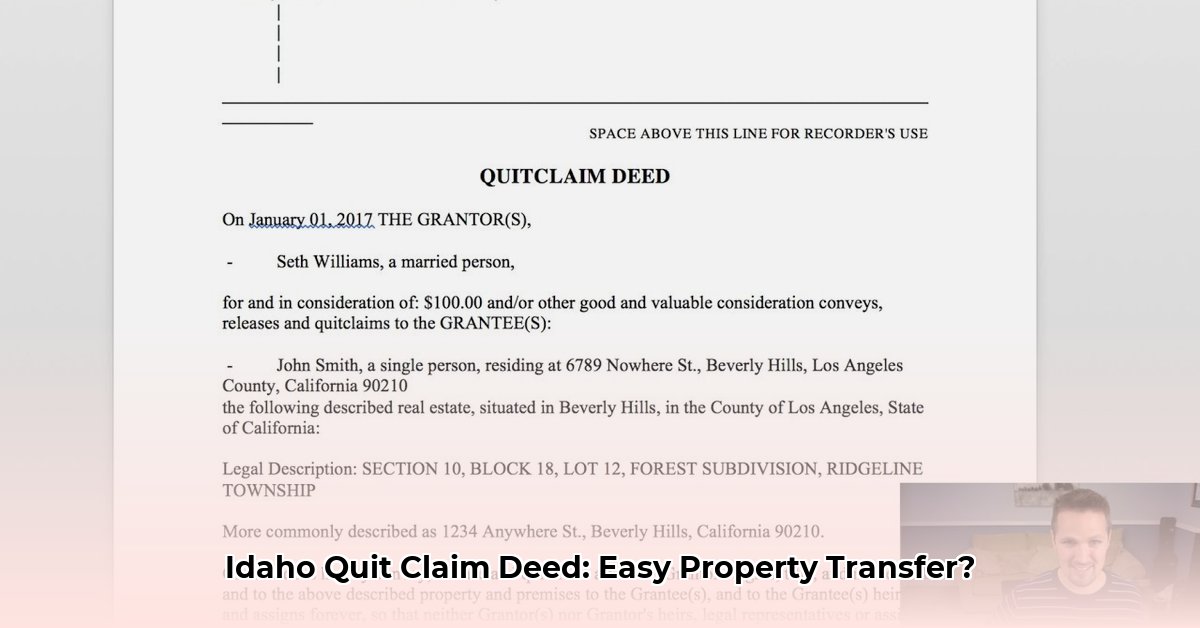
This guide provides clear, concise instructions on using quit claim deeds in Idaho. We'll cover when they're appropriate, the step-by-step process, and crucial legal considerations. Remember, while quit claim deeds offer a simple transfer method, they also carry significant risks. Always seek legal counsel before proceeding.
Understanding Idaho Quit Claim Deeds
A quit claim deed transfers ownership of real property in Idaho. Unlike a warranty deed, which guarantees clear title, a quit claim deed transfers only the grantor's interest, whatever that may be. This means the grantor makes no guarantees about the property's condition or the validity of the title. It's essentially a transfer of whatever interest the grantor possesses, "as is." This simplicity often makes it attractive, but it also carries substantial risks. Are you fully aware of those risks?
When to Use an Idaho Quit Claim Deed
Quit claim deeds are best suited for straightforward transfers between parties who understand the implications. Common scenarios include:
- Transferring property between family members (e.g., inheritance).
- Correcting minor title errors or inconsistencies.
- Resolving ownership disputes within a family context.
However, avoid using a quit claim deed in these situations:
- Purchasing property from an unknown party.
- Complex property transactions involving multiple parties.
- Situations requiring a clear and guaranteed title.
A warranty deed provides significantly more legal protection and is generally preferred for situations beyond simple family transfers.
Step-by-Step Guide to Using an Idaho Quit Claim Deed
Follow these steps carefully to ensure a legally sound transfer:
Obtain the Official Form: Download the official Idaho quit claim deed form from your county recorder's website. Using an unofficial form could invalidate the transfer.
Complete the Form Accurately: Fill out all fields completely and correctly. Use full legal names and addresses. Inaccuracies can lead to costly legal challenges. The accuracy of the information is critical for a legally valid transfer.
Notarization: Idaho law requires notarization. A notary public must witness the grantor's signature to ensure the deed's legitimacy and prevent fraud.
Filing with the County Recorder: Submit your completed and notarized deed to the county recorder's office where the property is located. Recording fees and processing times vary by county. Confirmation of successful filing is essential.
Potential Risks and Considerations
Using a quit claim deed carries significant risks:
- Undisclosed Encumbrances: The grantor is not responsible for any unknown liens, easements, or other encumbrances (legal burdens) on the property. The recipient assumes these risks.
- Liability for Defects: The grantor is liable for any defects in title or ownership they knew about at the time of transfer.
- Grantor’s Misrepresentation: If the grantor knowingly misrepresents the property’s condition or ownership, they could face legal action.
A thorough title search is strongly recommended to uncover any potential problems before transfer. Is this level of due diligence possible in your circumstances?
The Importance of Legal Counsel
Before using a quit claim deed, especially for anything beyond a simple family transfer, consult with an experienced Idaho real estate attorney. They can advise you on the legal implications, potential risks, and help ensure the process is completed properly. Legal guidance is crucial to avoid future complications. This investment in legal counsel can prevent far greater costs later.
Conclusion: Informed Decision-Making is Key
While simple to use, quit claim deeds in Idaho carry significant risks. Understanding the process, potential liabilities, and seeking legal advice when necessary will ensure that your property transfer is smoothly completed while safeguarding your legal position. Remember, careful planning and a thorough understanding of the process are vital.